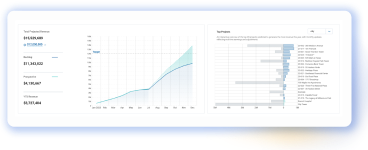Pay subs now.
Even before you get paid.
QuickPay covers subcontractor payouts instantly while you wait for payment from the owner, so your projects never stall.
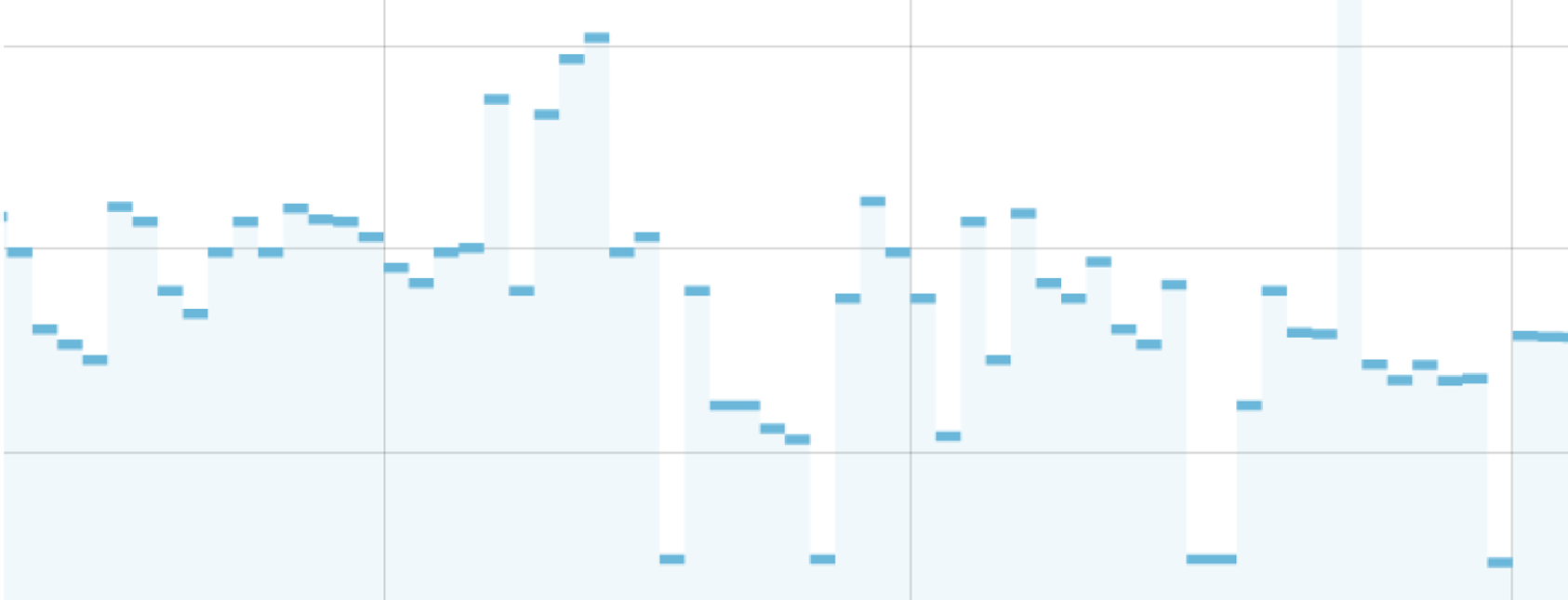
“Every extra day you add to DSO affects the bottom line. QuickPay helps protect your profit.”

built for construction
Don’t let the 90+ day payment lag from the owner slow you down
Accelerate payments
Boost profits
Ease administrative burden with AR & AP
How QuickPay works
QuickPay works with or without the ProNovos platform, making strategic payments faster for both general and specialty contractors.
General Contractors
Subcontractors
General Contractors
Enable QuickPay
No new systems or personal guarantees
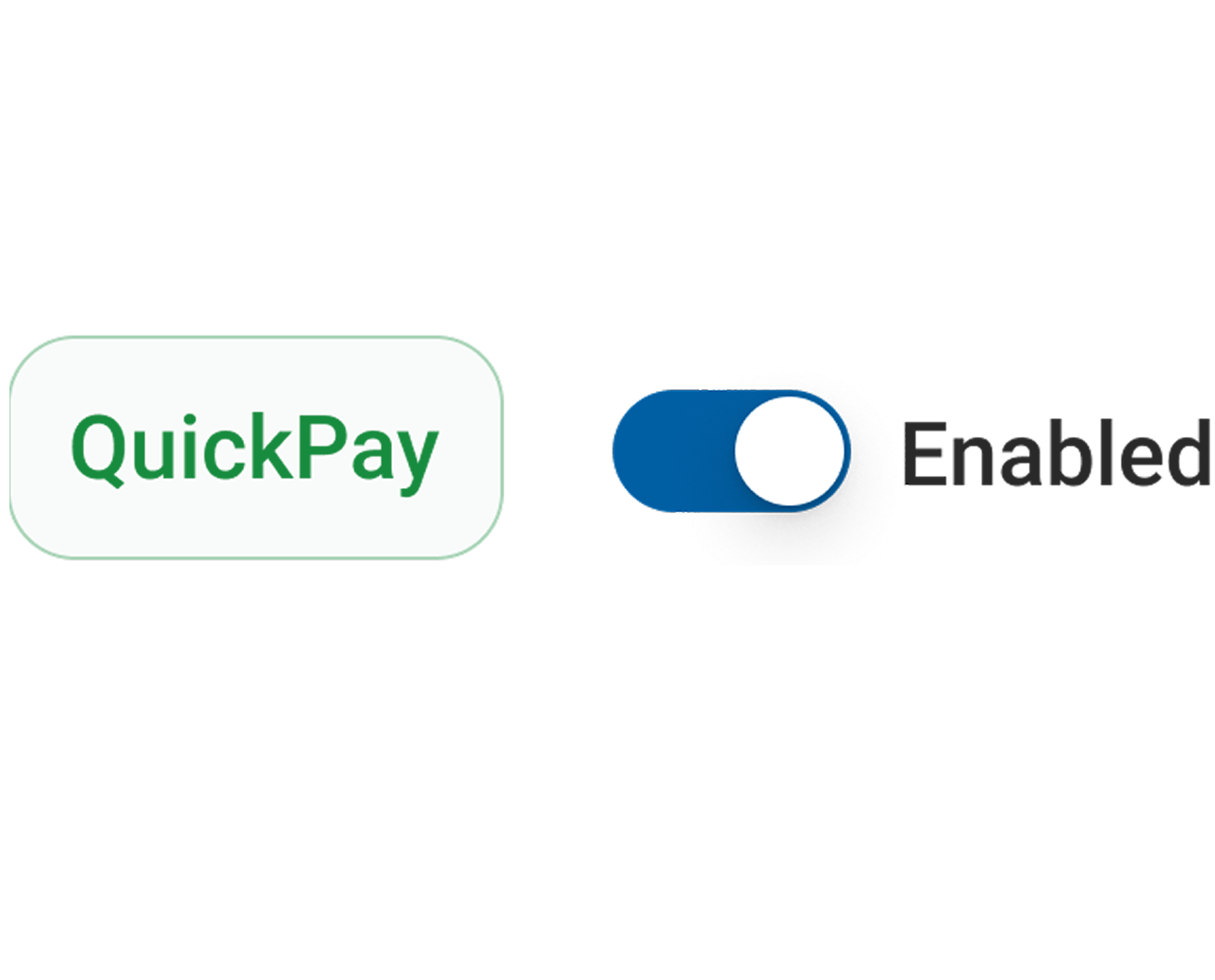
Log into ProNovos
See which invoices are eligible for early payment

Enable QuickPay

Select eligible invoices
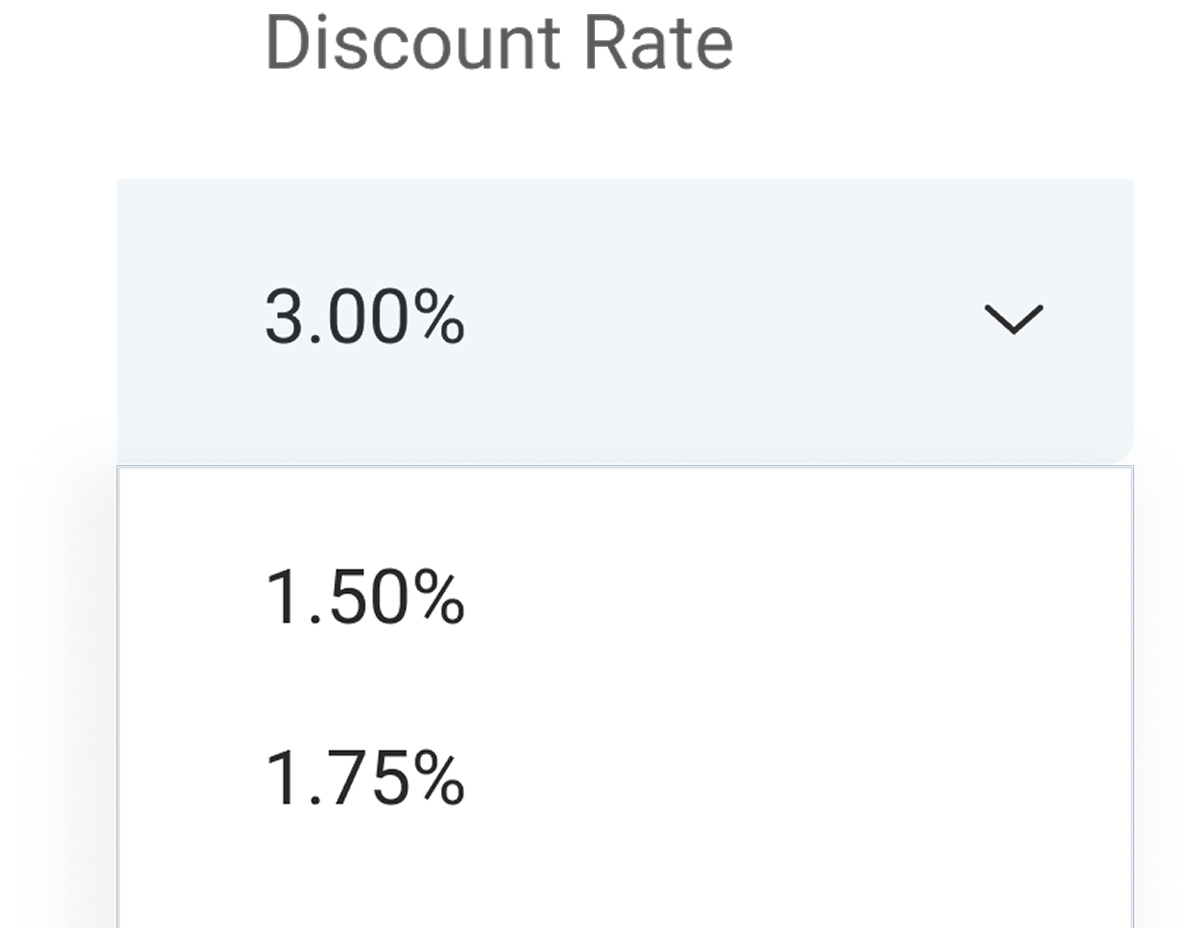
Payments are sent from a dedicated capital pool

Select eligible invoices
Choose invoices to make available for payment

Opt in with a click
Accept early payment in exchange for a discount
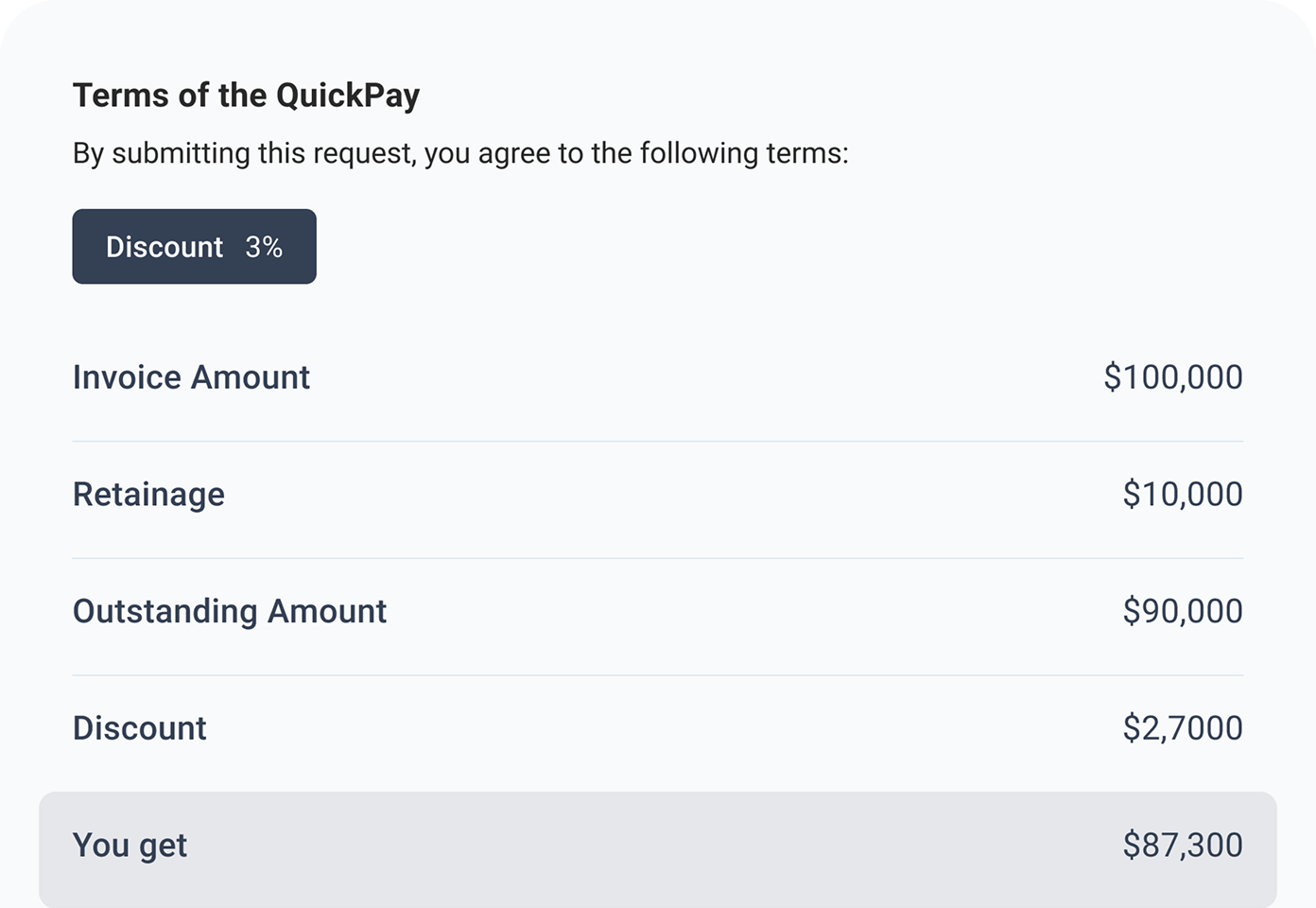
Let us fund it
Payments are sent from a dedicated capital pool

Get paid
Funds are sent quickly without extra paperwork

Subcontractors
Log into ProNovos

Opt in with a click

Get paid

Don’t put all your pressure on one financial lever
Each capital option has a role to play. Build a mix that supports both daily operations and long-term growth.
Cash flow shouldn’t wait
Use this calculator to see how much you and your subcontractors receive with QuickPay
Built for subs. Loved by GCs.

For GCs
Keep projects moving without draining working capital and strengthen subcontractor loyalty.

For subs
Get paid right away and plan cash flow with confidence. No more chasing payments.

For both
No hidden fees, no complicated setup: just select the invoice, and payment is made.
Fast. Flexible. Integrated.
QuickPay is a strategic capability backed by actual data and capital. And because it’s built inside ProNovos, you’re not logging into another system or introducing a separate process.
No matter which side of the payment chain you’re on, QuickPay puts you in control so you can keep building without financial slowdowns.
Retainage is not funded through QuickPay. All QuickPay percentages and calculations are based on the subcontractor’s pay app after retainage has been withheld.
For GCs: You keep full control over retainage, consistent with your agreements with the project owner.
For subs: QuickPay applies only to the portion of the pay app that is approved and payable, not to any retainage held back.
In very rare cases, a GC may choose to apply QuickPay to retainage at the end of a project, but this is the exception, not the rule.
From a legal standpoint, there are no issues. QuickPay funding never moves forward without GC approval, and retainage remains governed by the standard contract terms between the owner, GC, and sub.
QuickPay does not interfere with your existing payment platforms or processes. Everything between the GC and subcontractors continues exactly as it does today:
• Subs still submit pay apps through Textura, GC Pay, Procore Pay, or whichever platform is in use.
• GCs still review and approve through the same system.
• Subs go into the ProNovos platform and request QuickPay
The only difference is what happens after approval. Once the GC approves a pay app and authorizes QuickPay funding, Viva Capital issues an ACH payment directly to the subcontractor. This accelerates payment without changing or disrupting the workflows you already rely on.
In short, QuickPay sits alongside your existing payment system; it doesn’t replace or override it.
Nothing changes for the general contractor. The GC faces the same risk they would without QuickPay: if the owner doesn’t pay, the GC can’t pay downstream.
The only difference is that when a subcontractor has used QuickPay, they’ve transferred that risk to Viva Capital. In that case:
• The subcontractor has already been paid (at a discount).
• Viva Capital steps into the subcontractor’s position and assumes the risk of nonpayment.
• Viva Capital has the same rights as a subcontractor would; no more, no less.
This means the GC is not exposed to any new or additional risk. Instead, QuickPay benefits the subcontractor by removing their cash-flow burden, while Viva Capital carries the receivable risk.
QuickPay is primarily designed for prime contractors (general contractors) and their direct subcontractors. That’s the ideal and most common structure.
In some cases, Viva Capital may extend QuickPay to large subcontractors who subcontract portions of their work — but this is done only on an exception basis. Whether it’s offered depends on factors such as:
• Who the prime/general contractor is,
• Who the project owner is, and
• The nature of the subcontractor (typically specialized trades under a master subcontract).
So while QuickPay can flow through to second-tier subs, it’s not the primary goal of the program and is handled case by case.
It doesn’t. Pay-when-paid clauses remain fully intact and unchanged.
What QuickPay does is smooth out the burden of pay-when-paid for subcontractors. Once a sub opts in, they transfer their receivable to Viva Capital. Viva then funds the sub early, while taking on the pay-when-paid position.
From the GC’s perspective:
• The contractual obligation is the same.
• They still pay once the owner pays.
• They’re simply paying Viva Capital instead of the sub.
QuickPay does not accelerate, relieve, or add to the GC’s pay-when-paid obligations. It simply provides subcontractors with earlier access to cash flow.
For Subcontractors: There is no daily discounting. Subs are simply offered a flat discount (typically 1.75%–3%) off their approved pay app in exchange for receiving payment early. The discount rate is set by the general contractor, and the subcontractor can choose whether or not to accept it.
For General Contractors: The “daily rate” applies only on the backend, between Viva Capital and the GC. Once the GC approves a subcontractor’s pay app and Viva Capital funds it, the GC reimburses Viva Capital on a pay-when-paid basis.
How the GC benefits depend on when they pay Viva Capital. This creates a transparent daily revenue-sharing schedule that is agreed upon upfront in the QuickPay agreement.
None. When a general contractor signs the QuickPay agreement, they aren’t giving up any new rights. All they are doing is confirming that the subcontractor’s pay app has been reviewed, the work has been completed to their satisfaction, and the billing is valid.
Once approved, Viva Capital steps in to fund the subcontractor early. The GC’s payable doesn’t change — it’s the same amount, under the same contract terms, with the same obligation to pay once the owner pays. The only “risk” is the same one that already exists: the GC is dependent on the owner’s payment.
In short, QuickPay doesn’t alter the GC’s contractual rights or obligations; it just accelerates cash flow for subs.
Government projects are actually very well-suited for QuickPay. While government owners are typically reliable payers, they are often slow due to bureaucratic processes. This means subcontractors usually build the cost of carrying cash into their bids, driving up project costs.
QuickPay doesn’t change the owner’s obligation, whether private or government; the contract amount billed and paid stays the same. The general contractor approves the subcontractor’s pay app as usual, and Viva Capital steps in to fund the sub early. The GC still owes the same amount, on the same schedule, but QuickPay ensures the sub has working capital available sooner.
In practice, this helps subcontractors stabilize cash flow on projects where payment cycles are especially slow, without increasing risk or liability for the GC.
Yes. QuickPay is fully compatible with standard AIA construction contracts, which are commonly used on government projects. Nothing changes in terms of contract value or payment obligations. If a subcontractor bills $100,000 after retainage, the GC still approves and pays $100,000.
No. From the general contractor’s point of view, QuickPay doesn’t create new liabilities or deplete cash. The payable remains exactly the same; the only change is that Viva Capital steps in to fund the subcontractor early once the GC approves the pay app.
Because there’s no additional risk or working capital drain, senior lenders and bonding companies typically see no issues with QuickPay. In fact, they may view it positively. Subcontractors benefit from stabilized cash flow, while GCs can strengthen their profitability without adding debt. This stability is often attractive to both lenders and bonding companies.
There is no new liability created. QuickPay simply transfers the subcontractor’s receivable from the subcontractor to Viva Capital once the subcontractor opts in and accepts the discount. At that point, Viva Capital collects payment directly from the general contractor.
From the GC’s perspective, it’s the same payable they already owe — nothing new or increased. The only change is that the subcontractor gets paid earlier, while Viva Capital steps into their place as the payee.
Because the process is transparent, optional, and agreed to upfront, it remains clean and straightforward for all parties involved.
No. The reality is that subcontractors already build the cost of carrying cash into their bids, whether QuickPay exists or not. Without QuickPay, they may face 90–120 day payment cycles, which forces them to inflate bids to cover financing costs and negative cash flow.
With QuickPay, subcontractors gain a dependable cash cycle at a minimal cost. This actually reduces the need to inflate bids. In fact, we’ve seen that subcontractors often become more competitive when QuickPay is available, since they know they’ll have the option to be paid quickly and don’t need to price in long-term financing risks. This benefits both subs and general contractors, making their bids stronger and helping them win more projects.
